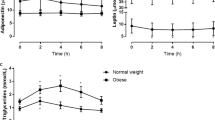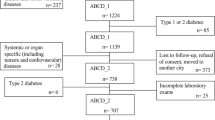Abstract
OBJECTIVE: To study the associations of obesity (as body mass index (BMI)), of body fat distribution (as waist to hip ratio (WHR)) and of β-endorphinaemia (β-EP-aemia) with fasting insulin and glucose concentrations, with insulin secretion (as first phase insulin response (FPIR)) and with insulin sensitivity (SI) in obese women.
DESIGN: a cross-sectional study of insulin sensitivity in obese women.
SUBJECTS: 45 obese women (age: 20–70 y, BMI: 27–50).
MEASUREMENTS: Frequently sampled intravenous glucose tolerance test (FSIGTT), FPIR, fasting glucose, fasting insulin, BMI, body fat topography (WHR), β-EP-aemia, plasma ACTH.
RESULTS: In univariate analysis the following positive associations were observed: fasting glucose with age and WHR, fasting insulin with BMI and WHR, β-EP plasma concentration with WHR; SI was negatively associated with BMI, WHR and β-EP plasma concentrations. This pattern of associations remained unaltered in multivariate analysis including age, BMI and WHR as independent variables. The contribution of β-EP plasma concentrations to SI variability was corroborated by a stepwise multiple regression analysis: 53.8% of SI variation could be explained by BMI (30.7%), by β-EP plasma concentrations (17.2%) and by WHR (5.9%). Finally, women were divided into two groups according to whether they had a peripheral (P-BFD, WHR≤0.80, n=24) or an abdominal (A-BFD, WHR≥0.85, n=16) body fat distribution. After adjustment for age and BMI, SI values were lower while β-EP and ACTH plasma concentrations were higher in the A-BFD compared to the P-BFD group. In this latter group, 54.8% of SI variation was explained by the same variables as in the whole group. In the A-BFD group, higher WHR was associated with lower FPIR.
CONCLUSIONS: 1) The major finding of this study is that, in non-diabetic obese women (especially those with a P-BFD), higher β-EP plasma concentrations are associated with lower insulin sensitivity. This association is independent of both the magnitude of obesity and the pattern of fat distribution, although these two parameters are strong predictors of SI. 2) The major reduction in SI observed in women with A-BFD probably results from the additive effects of obesity, of elevated β-EP plasma concentrations and of metabolic and endocrine alterations in relation with the central pattern of fat distribution.
Similar content being viewed by others
Author information
Authors and Affiliations
Rights and permissions
About this article
Cite this article
Percheron, C., Colette, C., Mariano-Goulart, D. et al. Relationship between insulin sensitivity, obesity, body fat distribution and β-endorphinaemia in obese women. Int J Obes 22, 143–148 (1998). https://doi.org/10.1038/sj.ijo.0800556
Received:
Revised:
Accepted:
Published:
Issue Date:
DOI: https://doi.org/10.1038/sj.ijo.0800556
- Springer Nature Limited
Keywords
This article is cited by
-
Adiposity, insulin and lipid metabolism in post-menopausal women
International Journal of Obesity (2002)




